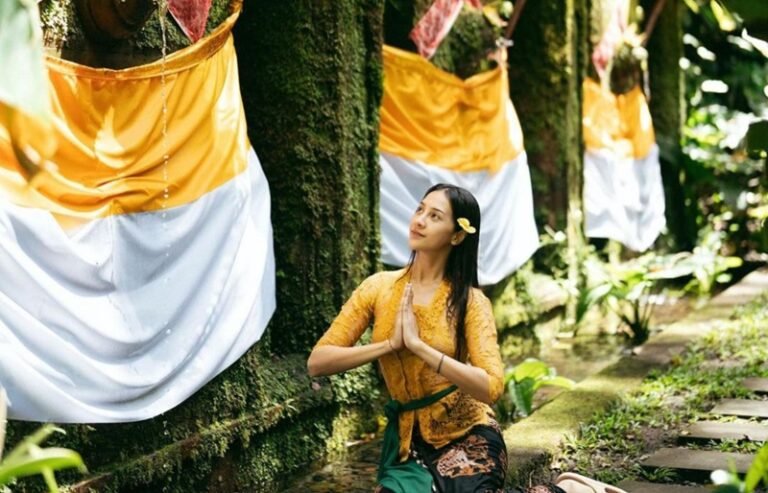5 Balinese traditional costume and attire explained vividly
Ever draped a kamben sarong (waist cloth) and felt like you were holding a quiet prayer?
When the songket silk (handwoven brocade) catches the sunrise, it glows golden.
Its lace edges whisper on your skin like a soft evening breeze.
Pure bliss.
Each fold is a nod to a Hindu god, a gentle promise of harmony and respect.
The kebaya blouse (embroidered top) hugs you with delicate grace.
And the udeng (Balinese headband) perches just so, weaving island tales into your day.
By the way, we’re about to explore five vibrant Balinese outfits.
You’ll learn how to wear each piece with easy confidence and quiet wonder.
Ready to slip into tradition? Let’s go.
Key Aspects of Balinese Traditional Costume and Attire
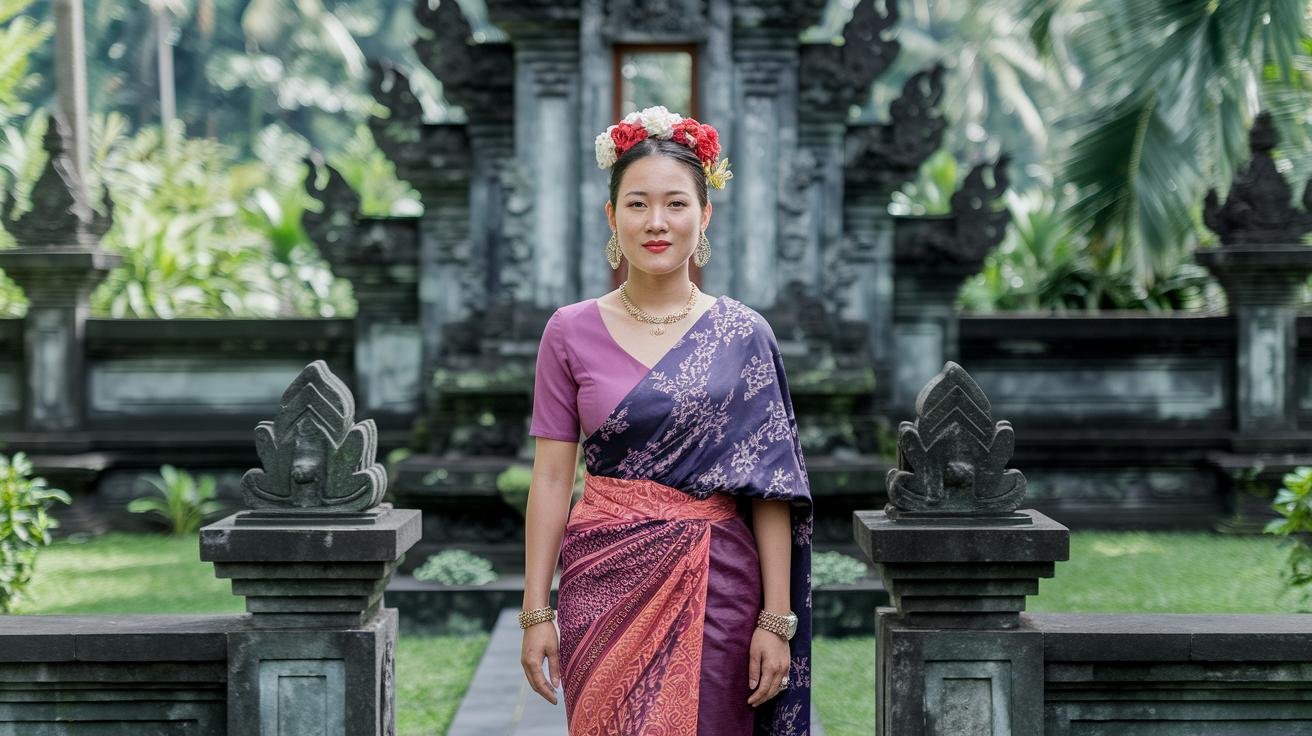
Imagine slipping into a fitted kebaya blouse over a crisp white baju shirt. Then wrap a kamben sarong (a waist cloth) just so. Ever wondered how that sarong stays in place all day? You might spot songket (silk woven with metallic threads) sparkling in the sun.
Or hand-stamped batik whispering island tales. Lace edges brush your skin like a soft evening breeze. Every hue pops against the rice terraces (stepped fields that glow emerald at sunrise). Pure comfort.
Every fold carries a story. A selendang sash (satin scarf) tied at your waist is a nod to self-control. A saput layer (an extra cloth wrap) adds depth and grace.
These clothes feel like prayers. Each knot and pleat honors a Hindu god and weaves in harmony, purity, and respect. Slip on a white shirt and add an udeng (headband) before a ceremony. Feel a gentle ritual pulse in your heartbeat.
The kebaya arrived in Bali between 1919 and 1931. At first only palace women wore it. Today it lives in every village home, welcoming anyone drawn to its delicate charm. One blouse shaping a culture.
Next, we’ll unpack each piece, from women’s kebaya to men’s udeng. And reveal the symbolism woven into every stitch. So you can dress with ease and respect.
Women’s Balinese Traditional Costume Components
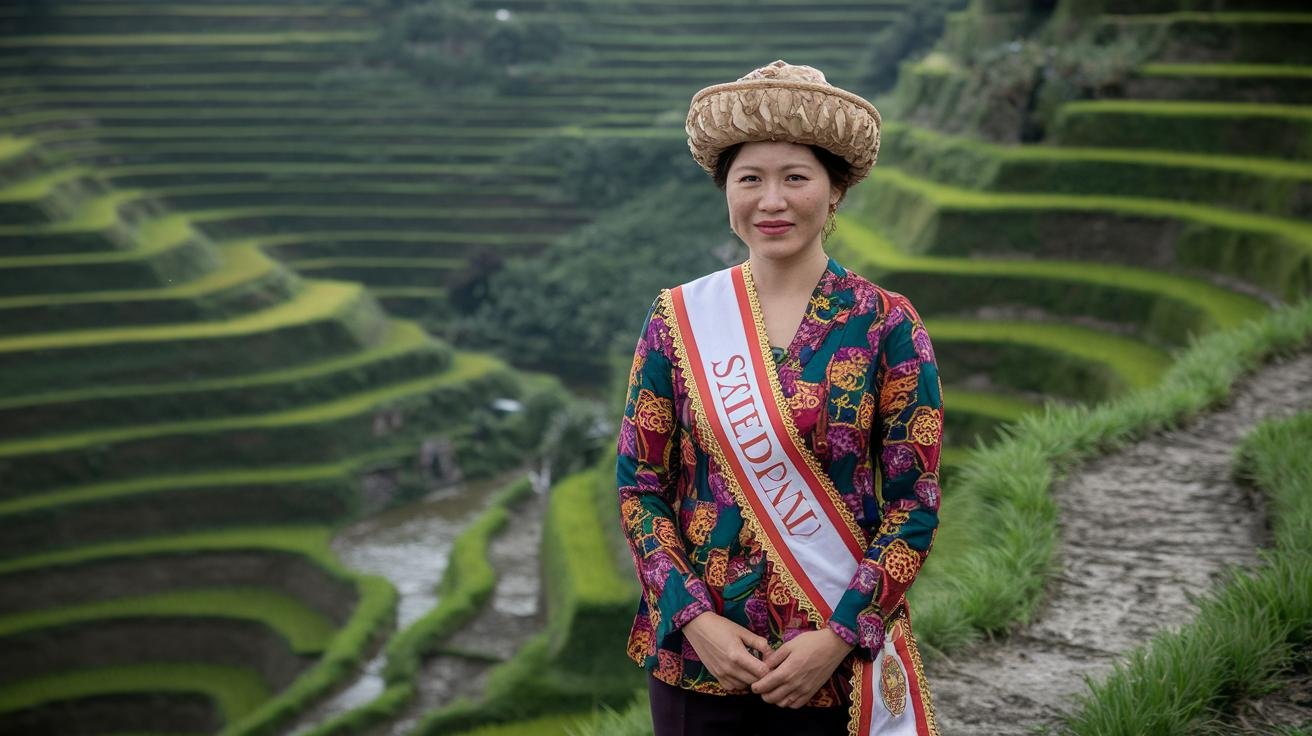
Picture slipping into a Balinese ceremonial outfit, it's like a gentle hug from centuries of tradition. Every piece whispers respect, humility, and harmony, oops, let me rephrase that, as if you’re stepping into a living poem. From sunrise prayers at the pura (temple) to colorful village festivals, you feel spirituality and artistry woven together. You almost hear the soft rustle of songket silk with every move.
Kebaya Bali
The kebaya Bali is a fitted blouse made of lace or brocade (rich, woven fabric) that wraps your torso in quiet grace. Embroidery traces floral motifs lifted straight from Balinese carvings. Slip it on and you’ll feel both elegant and grounded. The lightweight fabric lets your skin breathe in Bali’s warm breeze.
Kain Kamben and Songket Patterns
Next, you wrap the kain kamben around your waist, a long skirt cloth folded just like rice terraces (stepped fields that glow emerald at sunrise). Woven with songket techniques, metallic threads catch the sunlight in tiny sparks. Those bright patterns represent the universe and purity, each star-like motif a soft nod to the divine. Pure grace.
Selendang Sash and Prada Belt
Tie a selendang sash (a silky scarf) around your hips and pause for a moment of mindful calm. White ones are for temple visits; bold colors lift celebrations. Then secure it with a prada belt adorned in gold carvings, symbol of strength, fertility, and gentle protection. Adjusting it just right feels almost meditative.
Floral and Decorative Accessories
No Balinese ensemble is complete without blooms in your hair. Frangipani (plumeria) or jasmine garlands (tiny white flowers) drift a sweet scent with every turn. Combs and pins tuck petals into a neat bun or braid. A living prayer. Pure beauty.
Men's Balinese Traditional Costume Components
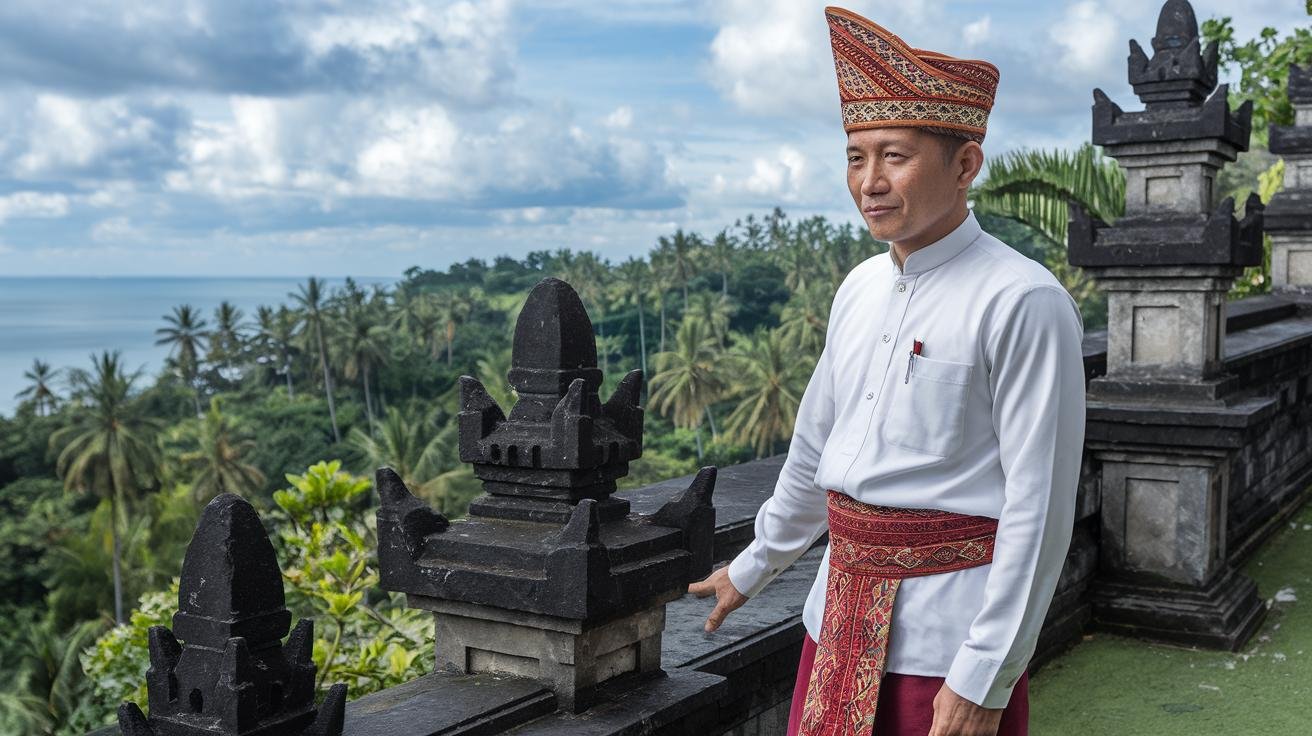
Stepping into a man’s Balinese outfit feels like joining a mindful ritual. You can almost hear the soft tap of temple drums as you wrap each layer. And the warm scent of frangipani (tropical blossom) drifts in with the breeze.
Udeng and Baju Shirt
First comes the udeng headpiece (folded cloth headband). You tie it with a gentle knot above your brow to center your thoughts. Ever felt that quiet pressure guiding your focus? Then you pull on a crisp white baju shirt (collared shirt) that settles like morning mist on your shoulders. Together they frame your face with simple dignity.
Kamen Sarong and Saput Layer
Next you wrap the kamen sarong (batik cloth) around your waist so the hem falls just below your knee. The batik patterns whisper island tales and honor the earth’s cycles. Then you drape the saput layer (an extra cloth wrap) over it. The soft rustle against your skin feels almost like a whispered prayer. Tranquility.
Waist Belt and Additional Accessories
Finally, you secure it all with a woven belt that cinches at your hips, a humble shield of strength. Its texture keeps every fold crisp through your steps and bows. You might tuck a small offering (a gift to the gods) into the belt or add a bright woven sash for a pop of color. Tiny touches that let your spirit show.
Symbolism of Colors and Fabrics in Balinese Traditional Attire
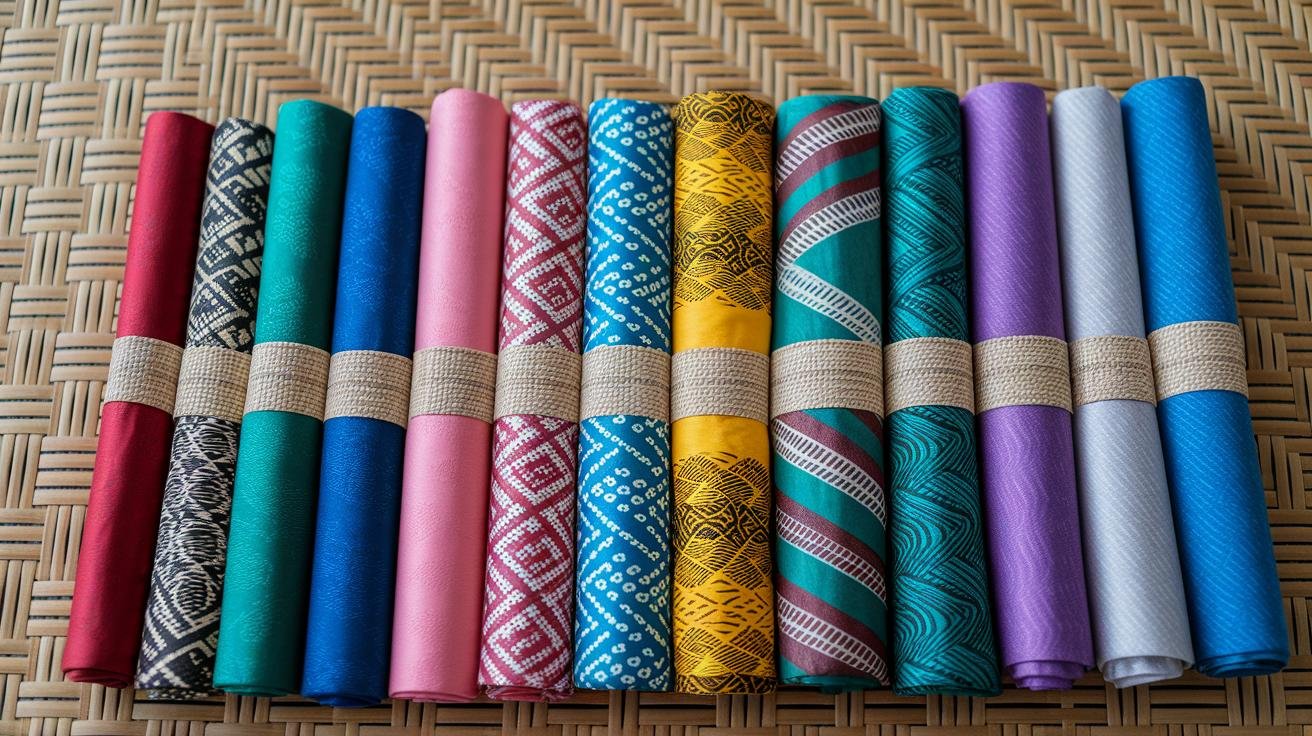
Colors in Balinese clothes do more than just look pretty. White feels like that first clean breath at dawn, soft and pure. It’s a quiet nod to truth and Shiva’s calm voice. Yellow glows like rice terraces (stepped fields that shine emerald at sunrise), a little prayer for Mahadeva’s light and good fortune.
Red beats like a soft drum under silk, whispering passion and life in Brahma’s embrace. Black wraps you in quiet strength, a gentle shield of balance from Vishnu. Move through temple courtyards or stroll along village paths, and each hue feels like a whispered blessing.
| Color | Meaning | Associated Deity |
|---|---|---|
| white | Purity & Truth | Shiva |
| yellow | Sacredness & Prosperity | Mahadeva |
| red | Passion & Life | Brahma |
| black | Protection & Balance | Vishnu |
Weavers start with Bali batik (a cloth art) and a canting wax pen. You’ll feel warm wax sketching tiny island tales on soft cotton or silk. Then there’s songket weaving. It folds gold or silver threads into the fabric so it shimmers with every step.
Ever wondered how those silver threads catch the sun? Pure magic.
Picking cotton, silk, or brocade is like choosing the perfect mood for your ceremony. White batik for morning prayers. Yellow songket for festival dances. Black brocade for quiet balance. Wearing these fabrics is like wrapping yourself in a living poem of belief and artistry.
Ceremony-Specific and Regional Variations in Balinese Attire
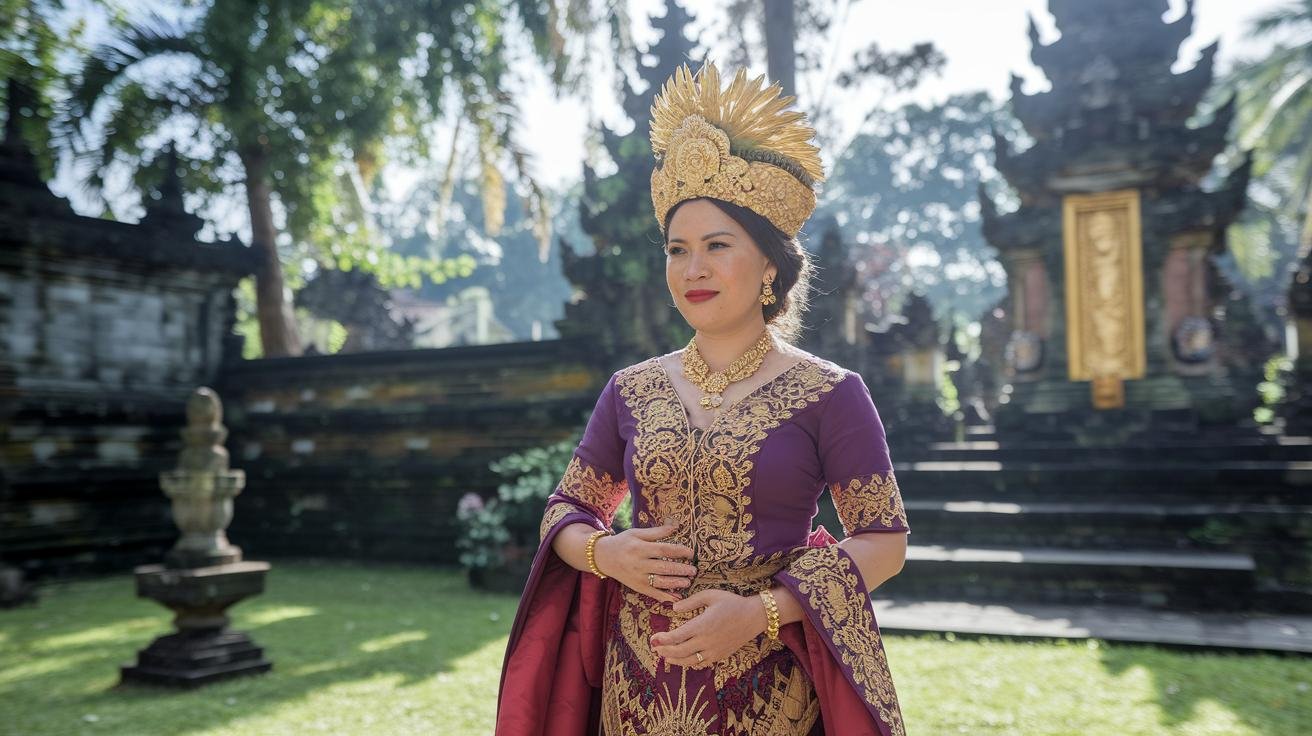
During temple ceremonies at the pura (temple), you might hear the soft murmur of prayers and smell sweet incense. Families slip into bright white sarongs and sunny yellow sashes for Galungan, Bali’s lively feast honoring ancestral spirits. Ever noticed how the colors almost glimmer at dawn?
Then on Kuningan day, songket (silk woven with gleaming metallic threads) winks with gold, a small nod to prosperity. Women fold their kebaya (blouse) and kain kamben (waist cloth) into neat, crisp layers. Men knot their udeng (headband) just above the brow. It’s solemn and joyful at once, like a sunrise prayer sprinkled with laughter. You won’t see flashy prints or low cuts here, everyone stays focused on respect and harmony.
Venture beyond Denpasar and you’ll find each village weaving its own story into cloth. In Singaraja up north, bold geometric borders frame their songket (silk with metallic threads), each pattern whispering a local legend. Down south in Bali Aga (mountain villages), earthy dyes stain cotton in deep browns and reds, with little spider and fish motifs honoring ancient mountain roots.
Hold a piece and you can almost hear the loom click-click under your fingers. Every village leaves a unique fingerprint, so no two ceremonial outfits are the same. Pure tapestry.
And then there’s the magic of dance costumes. In the Legong dance, performers don golden headdresses shaped like lotus petals and float in bright silk skirts that catch the light with every graceful turn.
Pendet dancers swirl in songket skirts traced with frangipani (fragrant flower) and jasmine (sweet white blossom), their steps an open-armed welcome. Rejang devotees choose white and yellow cloth, moving in slow, deliberate patterns that radiate devotion and purity.
With each twirl, the soft rustle of fabric carries centuries of ritual, and suddenly you’re part of the dance, too.
Practical Guide to Wearing, Renting, and Caring for Balinese Traditional Attire

Ever wandered into the little thatched stalls near most pura (temples)? You’ll spot kebaya (lace blouse), kain (traditional cloth), and udeng (headband) at prices that feel just right. Friendly vendors lean in with soft smiles, guiding your hands as you drape each piece. It’s like joining a timeless ceremony.
For men, start by tying the kamen sarong (ankle-length skirt) just below your knee. Then fold the saput (waist wrap) over at your waist, nice and tidy. Finally, slip on the udeng headband, knotting it gently above your brow. Feel that quiet calm settle in.
Ladies, wrap the kamen (skirt) snug around your hips. Smooth pleats with your fingertips until everything feels perfect. Next, drape the selendang sash (hip scarf) and tie a delicate bow. Ever sneaked a look in a mirror and felt a ritual pulse in your step?
Pure comfort.
Oops, I almost forgot the care part. Think of these fabrics as dancers needing a gentle touch. Hand-wash each piece in cool water with a mild detergent. Swirl softly, no rough scrubbing. Rinse until the water runs clear, then lay your cloth flat on a soft towel to air-dry, smoothing pleats again.
To keep your songket (brocade fabric) shimmering like dawn over rice terraces (stepped fields that glow emerald at sunrise), fold each piece with acid-free paper between layers. Tuck sashes and headbands away from direct sun and humidity in a cool drawer. Open it later, and that shimmer will still feel like magic.
Final Words
You’ve seen the heart of Balinese traditional attire, from fitted kebaya and songket sarongs to the udeng headpiece and selendang sash.
You’ve felt how colors, white, yellow, red, and black, speak of purity, prosperity, passion, and protection.
You’ve learned how ceremony styles shift from village weaves to dance costumes, and got tips on renting, wrapping, and caring for each piece.
This guide makes Balinese traditional costume and attire explained clear and ready for your next temple visit. Pure joy awaits.
FAQ
What is the traditional costume of Bali and its name?
The Balinese traditional costume combines a fitted kebaya blouse or white baju shirt with a wrapped kamben or kamen sarong, accented by a selendang sash or saput layer in songket, batik, or lace.
What does Bali traditional dress look like for males?
The male Balinese traditional dress features an udeng headband with an asymmetrical knot, a crisp white baju shirt, a wrapped kamen sarong, a saput overlayer, and a waist belt, symbolizing mental focus, purity, and strength.
What does Bali traditional dress look like for females?
The female Balinese traditional dress features a fitted lace kebaya blouse, a kamben songket skirt wrapped at the waist, a selendang sash, a prada belt with gold detailing, and floral hair accessories symbolizing elegance, purity, and self-control.
Where can I buy, rent, or order traditional Balinese clothing online?
You can buy or rent traditional Balinese clothing at local tailor shops and rental stalls near temples. Many online boutiques also ship songket, batik sarongs, kebaya blouses, and accessory sets worldwide.
Where can I find Bali traditional dress photos or arrange a costume photoshoot?
You can find Bali traditional dress photos and arrange a costume photoshoot with local photographers via social media portfolios, villa blogs, or hashtags like #BalineseCostume. Many studios offer rental outfits and photo packages.
What are the costumes like in Balinese dance?
Balinese dance costumes are ornate silk or songket layers adorned with golden headdresses, vibrant colors, and stylized motifs. Each element highlights the performance’s story, status, and spiritual symbolism.
What is the dress code for Bali, especially temple visits?
Everyday Bali dress is relaxed resort wear, but temple visits require modest clothing: covered shoulders and knees, a wrapped sarong at the waist, and a sash to show respect and harmony.
What do Balinese traditional costumes represent?
Balinese traditional costumes represent religious values like harmony, purity, respect, and devotion. Colors, fabrics, and motifs pay homage to deities and convey cultural identity during ceremonies and temple offerings.

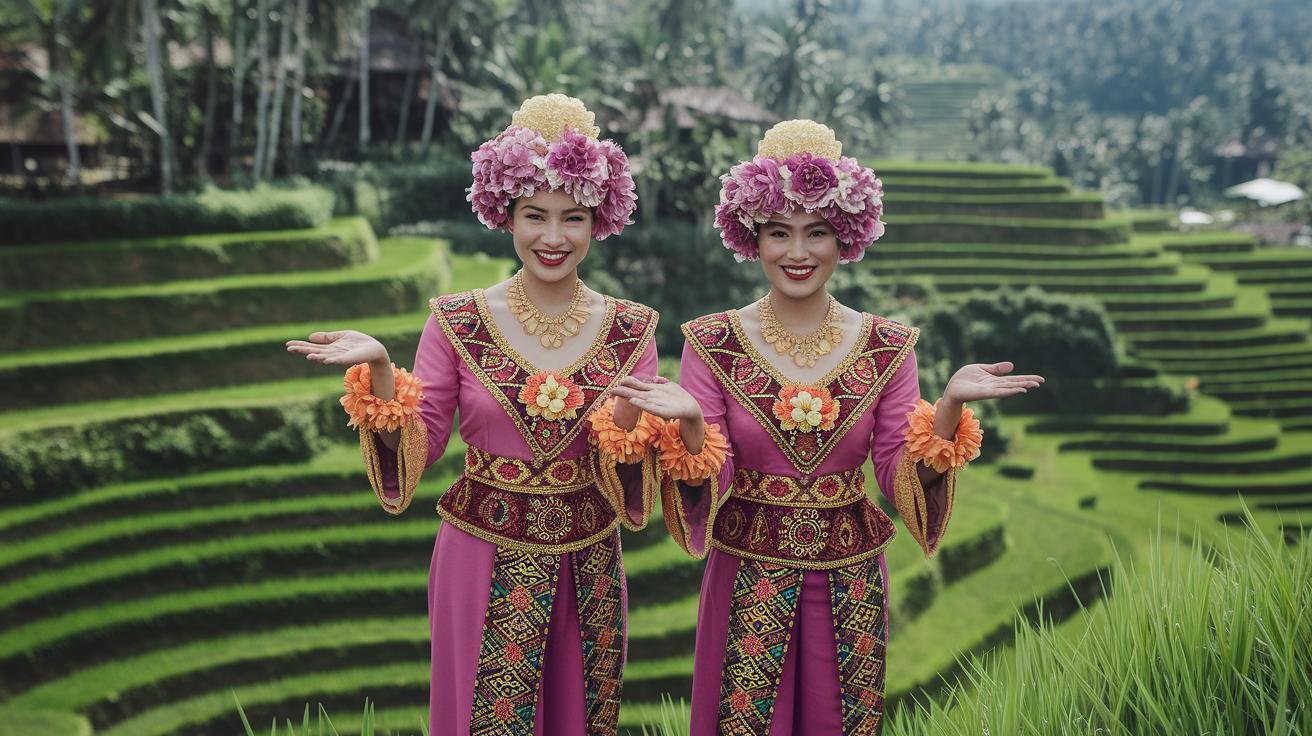




![sonder [son-der] the feeling one has on realizing that every other individual one sees has a life as full and real as one’s own, in which they are the central character and others, including oneself, have secondary or insignificant roles. In a state of sonder, each of us is at once a hero, a supporting cast member, and an extra in overlapping stories.](https://villaamrita.com/wp-content/uploads/2025/10/sonder-bali-and-villa-amrita-768x512.jpg)
